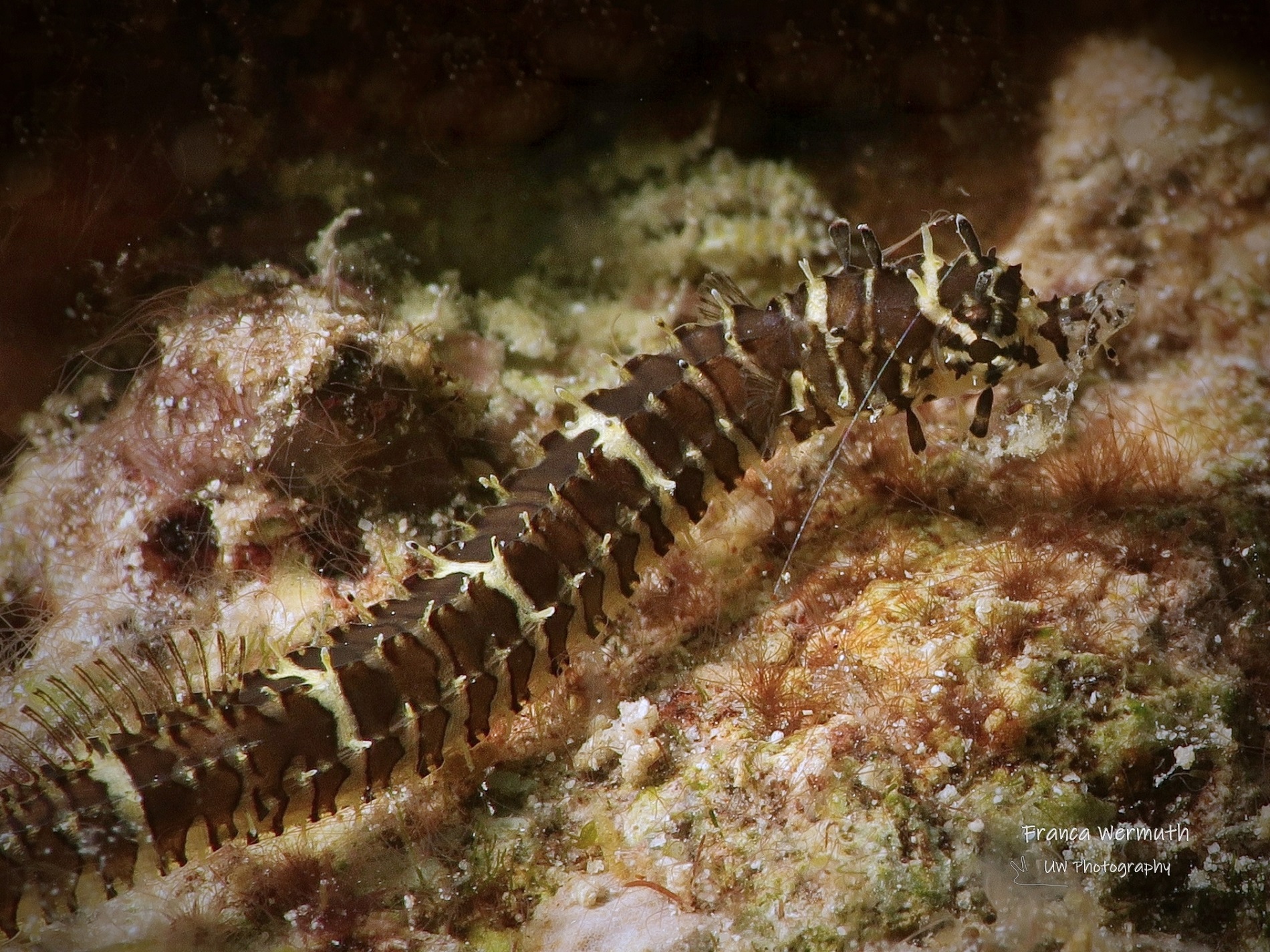Glittering Pipefish, Halicampus nitidus (Günther 1873)

A Glittering Pipefish, Halicampus nitidus, on a sandy slope at Romblon, Philippines, April 2018. Source: Franca Wermuth / iNaturalist.org. License: CC BY Attribution-Noncommercial
A greyish-brown pipefish with a distinctive zebra-like pattern of dark brown and irregular narrow silvery-white bands on the head and body.
Glittering Pipefish, Halicampus nitidus (Günther 1873)
More Info
|
Distribution |
Ningaloo Reef to the Monte Bello Islands and offshore reefs of north Western Australia, Ashmore Reef in the Timor Sea, and the northern Great Barrier Reef to the Swain Reefs, Queensland. Elsewhere the species occurs in the tropical, east-Indo-west Pacific. Inhabits crevices, rocks and rubble on coastal, lagoon and outer reefs to a depth of 20 m. |
|
Features |
Dorsal fin 18-22; Anal fin usually 3; Pectoral fin 11-14; Caudal fin 10; Trunk rings 13-15; Tail rings 30-32. Head short, length 8.2-10.7 in SL; snout short, length 2.9-3.7 in head length; snout depth 2.0-2.6 in snout length; median dorsal snout ridge discontinuous with 1-3 semi-isolated spines or crests; usually with 1-2 lateral spines on snout; lacks spines on postorbital or posterior supraorbital regions of head; dorsal rim of orbit slightly elevated; opercular ridge incomplete in adults; dermal flaps on head and body flat and broad. Principle body ridges elevated; margins of superior ridge serrate; rings often with a subterminal notch and a prominent spine-like point distally. Superior trunk and tail ridges discontinuous; inferior trunk ridge ending at anal ring; lateral trunk ridge confluent with inferior tail ridge Caudal fin tiny; pectoral-fin base clearly protruding laterally, with one distinct ridge. |
|
Size |
To 7.5 cm TL |
|
Colour |
Head and body with a pattern of alternating narrow dark reddish-brown and white bands. |
|
Feeding |
Preys on small crustaceans. |
|
Biology |
The eggs are brooded by the males in a semi-exposed pouch under the trunk. |
|
Fisheries |
|
|
Conservation |
IUCN Least Concern |
|
Remarks |
Ornamentation of the median dorsal snout ridge increases with age. Juveniles (19-20 mm SL) have a single spine or ridge-like crest on the snout, while larger individuals (longer than 60 mm) may have three ridge-like crests. |
|
Similar Species |
H. nitidis shares the modal count of 14 trunk rings, upturned opercular ridge and presence of one or more lateral spines or projections on the snout with H. spinirostris, H. brocki and H. dunkeri. However, H. nitidus is easily recognised from other members in the genus by differences in other meristics as well as its small size, less developed dermal flaps and striking colour pattern. |
|
Etymology |
The specific name is from the Latin nitidus (= shiny, gleaming), in reference to the whitish trunk rings which “stand out particularly due to their shiny white colour”. |
|
Species Citation |
Syngnathus nitidus Günther 1873, J. Mus. Godeffroy 1(2): Bowen, Queensland (as Australia). |
|
Author |
Thompson, V.J. & Bray, D.J. 2023 |
|
Resources |
Glittering Pipefish, Halicampus nitidus (Günther 1873)
References
Allen, G.R. 1993. Fishes of Ashmore Reef and Cartier Island. Records of the Western Australian Museum, Supplement 44: 67-91
Allen, G.R. 1997. Marine Fishes of Tropical Australia and South-east Asia. Perth : Western Australian Museum 292 pp. 106 pls.
Allen, G.R. 2000. Fishes of the Montebello Islands. Records of the Western Australian Museum, Supplement 59: 47-57
Allen, G.R. & Erdmann, M.V. 2012. Reef fishes of the East Indies. Perth : Tropical Reef Research 3 vols, 1260 pp.
Allen, G.R. & Russell, B.C. 1986. Part VII Fishes. pp. 79-103 in Berry, P.F. (ed.) Faunal Surveys of the Rowley Shoals, Scott Reef and Seringapatam Reef, northwestern Australia. Records of the Western Australian Museum, Supplement 25: 1-106
Dawson, C.E. 1985. Indo-Pacific Pipefishes (Red Sea to the Americas). Gulf Coast Research Laboratory, Ocean Springs, Mississippi. 230 pp.
Fricke, R. 2004. Review of the pipefishes and seahorses (Teleostei: Syngnathidae) of New Caledonia, with descriptions of five new species. Stuttgarter Beiträge zur Naturkunde. Serie A (Biologie). 66S: 1-66.
Günther, A. 1873. Erster ichthyologischer Beitrag nach Exemplaren aus dem Museum Godeffroy. Journal des Museum Godeffroy 1(2): 97-103.
Hamilton, H., Saarman, N., Short, G., Sellas, A.B., et al. 2016. Molecular phylogeny and patterns of diversification in syngnathid fishes. Molecular Phylogenetics and Evolution 107: 388-403 + supplement https://doi.org/10.1016/j.ympev.2016.10.003
Kuiter, R.H. 2000. Seahorses, Pipefishes and their Relatives. TMC Publishing, Chorleywood, UK. 240 pp. [as Halicampus sp 2].
Kuiter, R.H. 2009. Seahorses and their relatives. Seaford, Australia : Aquatic Photographics pp. 331.
Kuiter, R.H. & Tonozuka, T. 2001. Pictorial guide to Indonesian reef fishes. Part 1. Eels- Snappers, Muraenidae - Lutjanidae. Zoonetics, Australia. 302 pp.
Myers, R.F. 1999. Micronesian reef fishes. A comprehensive guide to the coral reef fishes of Micronesia. 3rd revised ed. Coral Graphics, Guam. 330 pp, 192 pls.
Paulus, T. 1999. Family Syngnathidae. pp. 2264-2276 in Carpenter, K.E. & Niem, T.H. (eds). The Living Marine Resources of the Western Central Pacific. FAO Species Identification Guide for Fisheries Purposes. Rome : FAO Vol. 4 pp. 2069-2790.
Randall, J.E. 2005. Reef and shore fishes of the South Pacific. New Caledonia to Tahiti and the Pitcairn Islands. 707 pp.
Randall, J.E., Allen, G.R. & R.C. Steene. 1997. Fishes of the Great Barrier Reef and Coral Sea. Crawford House Press. Bathurst. 557 pp.
Russell, B.C., Larson, H.K., Hutchins, J.B. & Allen, G.R. 2005. Reef fishes of the Sahul Shelf. The Beagle, Records of the Museums and Art Galleries of the Northern Territory Supplement 1 2005: 83-105
Senou, H. & M. Aizawa. 1993. Two rare species of the genus Halicampus (Pisces; Syngnathidae) from the Ryukyu Islands. I. O. P. Diving News 4(1): 4-5. [In Japanese, English abstract.]
Vaidyanathan, T. & Pollom, R. 2016. Halicampus nitidus (errata version published in 2017). The IUCN Red List of Threatened Species 2016: e.T65367783A115423734. https://dx.doi.org/10.2305/IUCN.UK.2016-3.RLTS.T65367783A67624512.en. Accessed on 09 January 2023.



